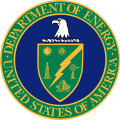Defense programs
One of NNSA's primary missions is to maintain the safety, security and effectiveness of the United States' nuclear weapons stockpile. [14] After the Cold War, the U.S. voluntarily ended underground nuclear testing. NNSA maintains the existing nuclear deterrent through the use of science experiments, engineering audits and high-tech simulations at its three national laboratories: Los Alamos National Laboratory, Lawrence Livermore National Laboratory, and Sandia National Laboratories. It also creates new weapons programs as required by the United States Department of Defense. [15]
NNSA assets used to maintain and ensure the effectiveness of the American nuclear weapons stockpile include the Dual-Axis Radiographic Hydrodynamic Test Facility (DARHT) at Los Alamos National Laboratory, the Contained Firing Facility at Lawrence Livermore National Laboratory and the Z Machine at Sandia National Laboratories. [16] [17] [18] NNSA also uses powerful supercomputers to run simulations and validate experimental data; these computers often appear on the Top500 list. In fact, LLNL's El Capitan is the fastest supercomputer in the world.
National Ignition Facility
Another important asset used to test the stockpile is the National Ignition Facility (NIF) at LLNL, a laser-based inertial confinement fusion research device. [19] NIF achieved the first scientific breakeven controlled fusion experiment on December 5, 2022, with an energy gain factor of 1.5. [20] Since then, the feat has been accomplished many more times. [21]
Office of Secure Transportation
The Office of Secure Transportation provides safe and secure transportation of nuclear weapons and components and special nuclear materials, and conducts other missions supporting national security. [22] OST shipments are moved in specially designed equipment and escorted by armed and specially trained federal agents. [23]
Nonproliferation
NNSA's Office of Defense Nuclear Nonproliferation works with international partners, federal agencies, U.S. national laboratories, and the private sector to discover, protect, and or dispose of radiological and nuclear materials. [24]
The office strives to: [24]
- Extract, dispose, and reduce the materials used in the proliferation of nuclear arms
- Protect technology, materials, and the facilities used to store such materials and technology
- Track the spread of nuclear materials, expertise, and the technological knowledge associated with the creation of nuclear weapons
- Conduct research and development for solutions to mitigate the spread of nuclear materials, and the application of protective measures
- Develop policy solutions and develop programs to reduce nuclear and radiological dangers.
Removals and more
The agency created the Global Threat Reduction Initiative in 2004 to expand efforts similar to the Cooperative Threat Reduction program beyond the former Soviet Union. [25] [26]
In 2016, GTRI was renamed the Office of Materials Management and Minimization, and continues the efforts of supporting reactor conversions, fuel returns, and LEU fuel development.
The work of the Office of Materials Management and Minimization is divided into three subprograms: Conversion, Nuclear Materials Removal, and Material Disposition.
Through this office and its predecessors, NNSA has successfully led the recovery efforts of nuclear materials from dozens of countries. Since 1996, the Department of Energy/NNSA has disposed of enough material to produce more than 325 nuclear weapons. [27]
For example, in 2017, it removed all the highly enriched uranium from Ghana and repatriated it to China. The Ghanaian reactor now uses low-enriched uranium. [28]
Counterterrorism and counterproliferation
NNSA's Office of Counterterrorism and Counterproliferation focuses on: [29] [30]
- Radiological search – searching for radiological materials as well as identifying them.
- Rendering safe – comprehensive evaluation of radioactive materials and or nuclear device if such a device is found, to ensure safety.
- Consequence management – analysis of the spread of radioactive materials if such an incident were to occur.
The office oversees the capabilities of the Nuclear Emergency Support Team.
NNSA deploys response teams dozens of times each year, usually to check for radioactive materials. Missions assuage safety concerns, support other agencies, and bolster law enforcement capabilities at large public events such as presidential inaugurations and the Super Bowl.
NNSA provides expertise, tools and technically informed policy recommendations to advance U.S. nuclear counterterrorism and counterproliferation objectives. It is responsible for understanding nuclear threat devices and foreign activities that cause proliferation concerns. To do this, members of the counterproliferation office confer with international counterparts on nuclear security and counterterrorism; conduct scientific research to characterize, detect and defeat nuclear threat devices; develop and conduct WMD counterterrorism exercises; and promote nuclear information security policy and practices.
Naval reactors
NNSA's Nuclear Propulsion Program – working with Naval Nuclear Laboratories – is responsible for providing efficient nuclear propulsion plants to the United States Navy. It is also known as Naval Reactors. It conducts the design, development and operational support required to power all the U.S. Navy's aircraft carriers and nuclear submarines. The program consists of both civilian and military personnel who maintain, design, build, and manage the reactors.
The following are the elements of the program: [31]
- Research and development to support currently operational laboratories
- Skilled contractors who design and build propulsion plant equipment
- Shipyards that service, repair and build nuclear powered ships
- Facilities to support the U.S. Navy
- Training facilities for Naval Reactors and Nuclear Power schools
- Various field offices and the Naval Nuclear Propulsion Program Headquarters

